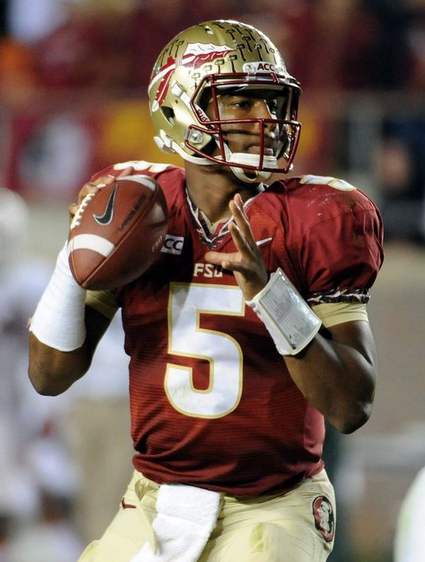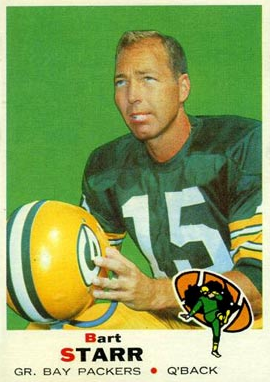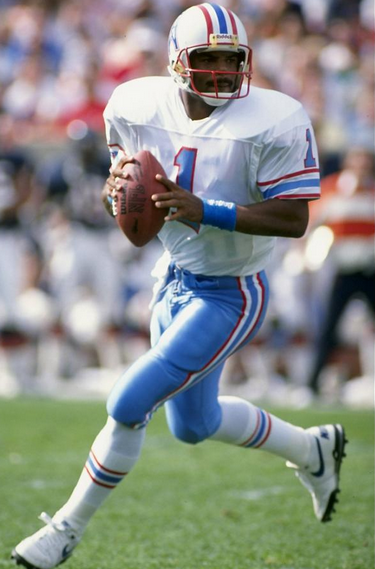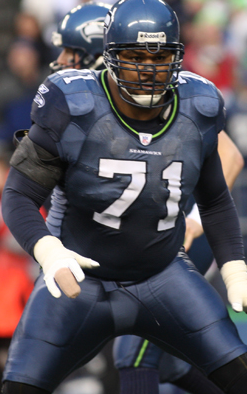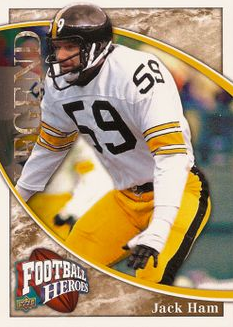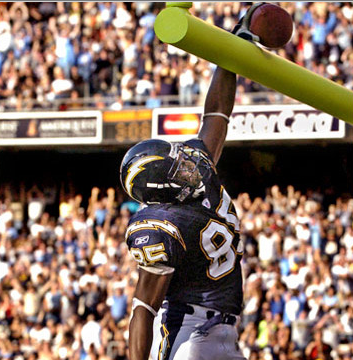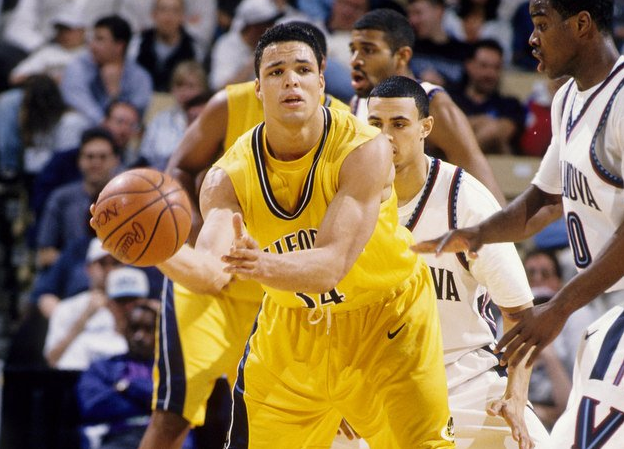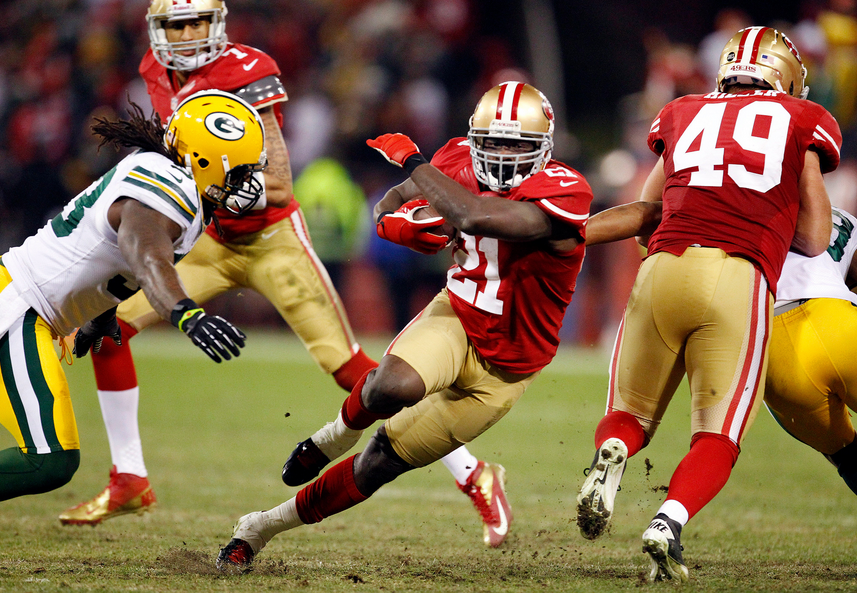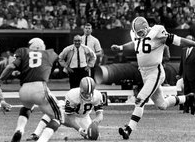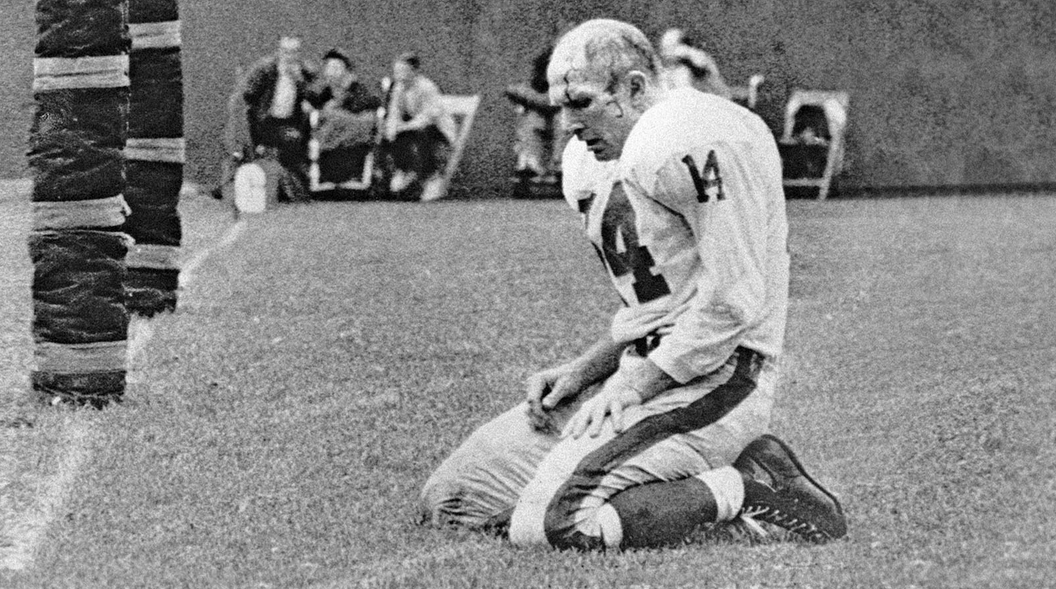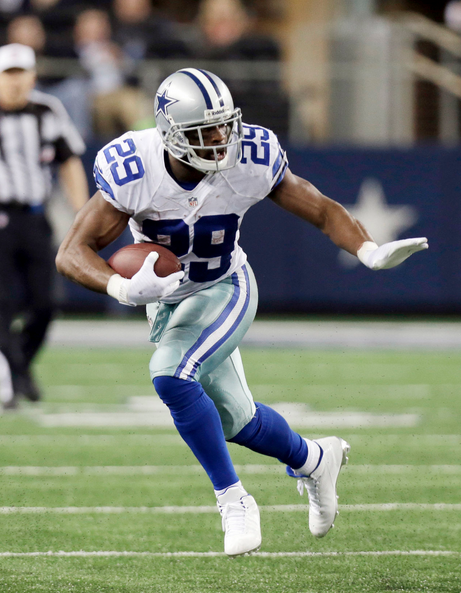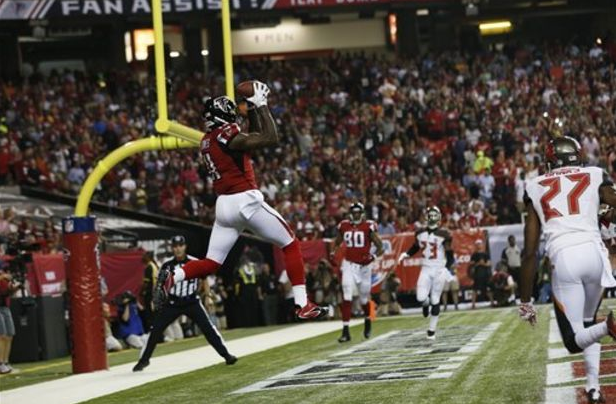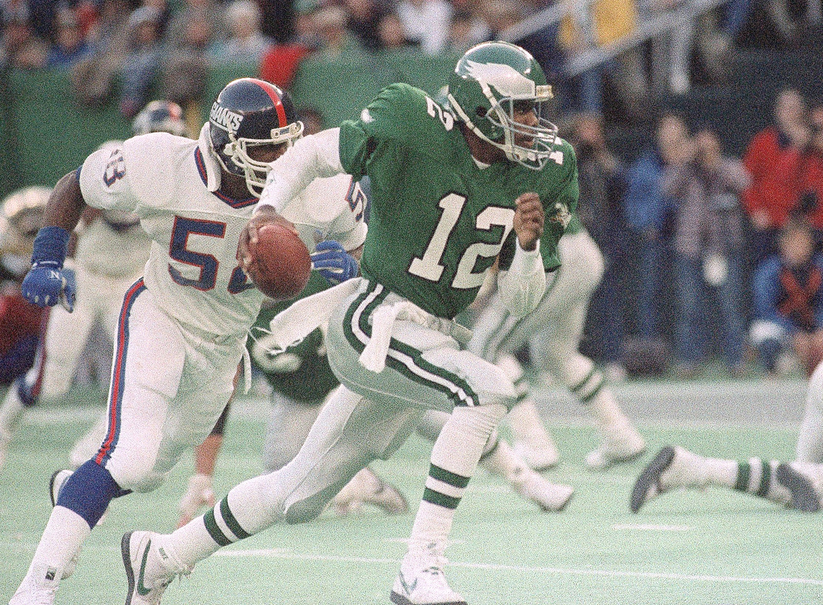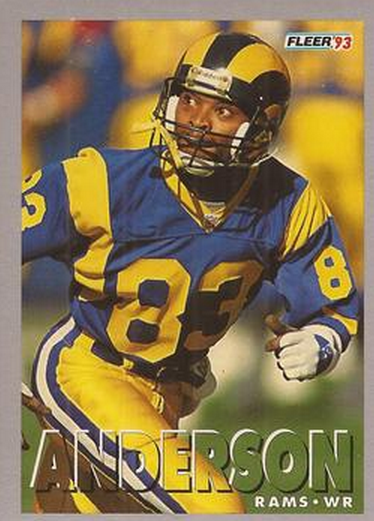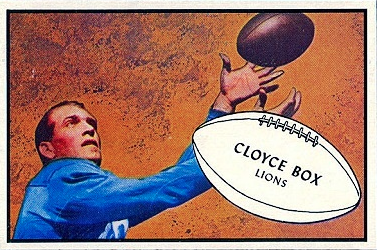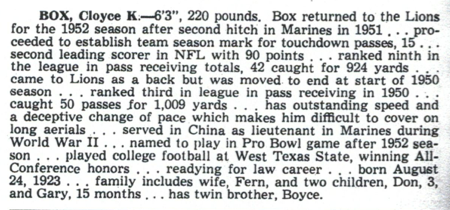Once again the NFL Draft World is abuzz about two quarterbacks. Who’s better, Jameis Winston or Marcus Mariota? More importantly, who’s going to have the better career? The Bucs, for one, are convinced the fate of the franchise hinges on it. (Until the next time they have the first pick, that is.)
But there’s another question that’s worth asking here: Does it really matter as much as everybody seems to think it does? By that I mean: If there’s a Hall of Fame quarterback in this draft, what are the odds Tampa Bay — or any other team in the market for a QB — knows for sure who the Future Legend is? You’d be surprised at the league’s sorry track record in this area.
By my count, there have been 24 Hall of Fame quarterbacks who have been available in the draft. This doesn’t include Steve Young, who originally cast his lot with USFL (and came to the NFL via a supplemental draft), or George Blanda (who made the Hall as much for his kicking as his throwing). Our QBs date all the way back to 1937, the second of the league’s 79 drafts, when the Redskins took Sammy Baugh sixth overall.
Want to guess how many of these Quarterbacks For The Ages were the first QB selected in their draft? Answer: four. One out of every six. Heck, Warren Moon didn’t even get drafted in 1978 — and there were 12 rounds that year. And again, we’re talking about Canton-quality players, not Pro Bowlers (whatever that means anymore) or long-term starters. Seems like those types — Hall types — should be more obvious.
When I started researching this the other day, I never imagined the number — four out of 24 — would be so low. It’s not like the inexact science of evaluating talent is getting any more exact, either. In my mind, there are seven active or recently active quarterbacks who are likely headed to the Hall: Brett Favre, Kurt Warner, Peyton Manning, Tom Brady, Drew Brees, Ben Roethlisberger and Aaron Rodgers. Only one of them was the first QB picked in his draft (Manning, who went first overall). One in seven. That’s worse than one in six.
Consider: In 1944 there were two Hall of Fame quarterbacks up for grabs — Otto Graham and Bob Waterfield. Neither was the first QB selected. (That distinction went to Heisman Trophy winner Angelo Bertelli.) It was the same story in ’57, the draft that gave us Len Dawson and Sonny Jurgensen. The first passer off the board? John Brodie.
In ’83, meanwhile, John Elway was the No. 1 pick (and went on to Canton), but two other Hall-bound quarterbacks in that draft, Jim Kelly and Dan Marino, were the third and sixth QBs chosen.
Even if a quarterback has Hall of Fame ability, in other words, it may not be easily identifiable in his early 20s. So why, given this history, are teams always falling over one another to move up in the first round and draft a QB, often at inflated prices? A better strategy might be to stay put and take whichever one falls to you. Granted, it doesn’t look as good public-relations-wise; you’re not being “aggressive” and “proactive,” merely patient and calculating. But if you end up with a better QB than the one you might have gotten (and as an added bonus, didn’t trade a truckload of picks for him), who cares?
Here are the details on the 24 Hall of Fame quarterbacks in the Draft Era (1936 to present):
● 1937 — Sammy Baugh, Redskins (6th pick) and Ace Parker, Dodgers (13th). Two QBs/tailbacks (the single wing was still in vogue, remember) were taken ahead of Baugh : Ed Goddard (Dodgers, 2nd) and Ray Buivid (Bears, 3rd). Three QBs/TBs, including Sammy, were taken ahead of Parker. (FYI: Goddard lasted exactly four games with Brooklyn. When he didn’t play heroically enough to justify his high salary, coach Potsy Clark released him in the middle of the season. So it went in those days.)
● 1939 — Sid Luckman, Bears (2nd). The first QB/TB picked.
● 1944 — Otto Graham, Lions (4th) and Bob Waterfield, Rams (42nd). One QB/TB was selected before Graham: Heisman Trophy winner Angelo Bertelli (Boston Yanks, 1st). Otto wound up signing with the Browns of the rival All-America Conference. Three QBs/TBs, including Otto, were selected before Waterfield, TB Dick Evans (Bears, 9th) being the other.
● 1948 — Bobby Layne, Bears (3rd) and Y.A. Tittle, Lions (6th). One QB went before Layne: Harry Gilmer (Redskins, 1st). Two, including Bobby, went before Tittle. Just think: Detroit drafted two Hall of Fame passers in five years (Graham and Y.A., who opted for the AAC’s Baltimore Colts) and lost both to The Other League.
● 1949 — Norm Van Brocklin, Rams (37th). Six QBs/TBs came off the board before him: John Rauch (Lions 2nd), Stan Heath (Packers, 5th), Bobby Thomason (Rams, 7th), Frank Tripucka (Eagles, 9th), Bob DeMoss (New York Bulldogs, 13th) and Joe Geri (Steelers, 36th). That’s right, Van Brocklin, who won two NFL championships, wasn’t even the first QB drafted by his own team in ’49. (Geri, by the way, was a tailback. Pittsburgh was the last club to run the single wing, stubbornly sticking with it until the ’50s.)
● 1955 — Johnny Unitas, Steelers (102nd). Three QBs were taken ahead of him: George Shaw (Colts, 1st), Ralph Guglielmi (Redskins, 4th) and Dave Leggett (Cardinals, 74th).
● 1956 — Bart Starr, Packers (200th). Eight QBs were selected before him, a mostly motley crew featuring Earl Morrall (49ers, 2nd), John Roach (Cardinals, 31st) and Fred Wyant (Redskins, 36th).
● 1957 — Len Dawson, Steelers (5th) and Sonny Jurgensen, Eagles (43rd). One QB went before Dawson: John Brodie (49ers, third). Five went before Jurgensen, the others being Milt Plum (Browns, 17th), Ronnie Knox (Bears, 37th) and Bobby Cox (Rams, 38th). Knox chose the CFL over the NFL.
● 1961 — Fran Tarkenton, Vikings (29th). Two QBs came off the board before him: Norm Snead (Redskins, 2nd) and Billy Kilmer (49ers, 11th).
● 1964 — Roger Staubach, Cowboys (129th). Eight QBs were taken ahead of him, Pete Beathard (Lions, 5th), Bill Munson (Rams, 7th), George Mira (49ers, 15th) and Jack Concannon (Eagles, 16th), most notably. Of course, Staubach would have gone higher if he hadn’t had to serve a 4-year military commitment after graduating from the Naval Academy.
● 1965 — Joe Namath, Cardinals (12th). Namath was the top pick in the AFL draft but only the second QB selected by the NFL. Craig Morton (Cowboys, 5th) was the first.
● 1967 — Bob Griese, Dolphins (4th). One QB went before him: Heisman winner Steve Spurrier (49ers, 3rd).
● 1970 — Terry Bradshaw, Steelers (1st). Obviously, he was the first QB picked.
● 1973 — Dan Fouts, Chargers (64th). Five QBs came off the board before him: Bert Jones (Colts, 2nd), Gary Huff (Bears, 33rd), Ron Jaworski (Rams, 37th), Gary Keithley (Cardinals, 45th) and Joe Ferguson (57th).
● 1978 — Warren Moon was passed over on Draft Day despite quarterbacking Washington to the Rose Bowl (and winning game MVP honors). So he starred in Canada for six years before the Houston Oilers threw a big contract at him. Fourteen quarterbacks were taken in the ’78 draft, but only one in the first round: Doug Williams (Bucs, 17th).
● 1979 — Joe Montana, 49ers (82nd). Three QBs were selected before him: Jack Thompson (Bengals, 3rd), Phil Simms (Giants, 7th) and Steve Fuller (Chiefs, 23rd).
● 1983 — John Elway (Broncos, 1st), Jim Kelly (Bills, 14th) and Dan Marino (Dolphins, 27th). Elway was the first QB off the board, Kelly the third and Marino the sixth. The others who went in the first round: Todd Blackledge (Chiefs, 7th), Tony Eason (Patriots, 15th) and Ken O’Brien (Jets, 24th).
1989 — Troy Aikman (Cowboys, 1st). The first QB picked. But . . . if the University of Miami’s Steve Walsh had been available in the regular draft, would Dallas’ Jimmy Johnson have chosen him over Aikman? Johnson liked him enough to grab him in the first round of the supplemental draft (and let the two young passers compete for the starting job).
Now for the seven quarterbacks who are locks – or semi-locks – for the Hall of Fame:
● 1991 — Brett Favre (Falcons, 33rd). Two QBs were taken ahead of him: Dan McGwire (Seahawks, 15th) and Todd Marinovich (Raiders, 24th).
● 1994 — Kurt Warner (Packers, undrafted free agent). Nine QBs were selected that year — the regrettable Heath Shuler (Redskins, 3rd) for starters — but Warner, who played in obscurity at Northern Iowa, wasn’t among them. After stints in the Arena League and NFL Europe, he improbably led the Rams and Cardinals to a total of three Super Bowls.
● 1998 — Peyton Manning (Colts, 1st). Numero uno.
● 2000 — Tom Brady (Patriots, 199th). Six QBs went before him, a pedestrian group consisting of Chad Pennington (Jets, 18th), Giovanni Carmozzi (49ers, 68th), Chris Redman (Ravens, 75th), Tee Martin (Steelers, 163rd), Marc Bulger (Rams, 168th) and Spurgon Wynn (Browns 183rd).
● 2001 — Drew Brees (Chargers, 32nd). The second QB off the board, 31 picks after Michael Vick (Falcons, 1st).
● 2004 — Ben Roethlisberger (Steelers, 11th). Two QBs were taken ahead of him: Eli Manning (Chargers, 1st) and Philip Rivers (Giants, 4th). Manning and Rivers, who were swapped on Draft Day when Eli balked at signing with San Diego, have had good-to-very good careers, but Big Ben is the only one in the bunch who has been to three Super Bowls (winning two).
● 2005 — Aaron Rodgers (Packers, 24th). The second QB selected, several long hours (in Green Room Time) after Alex Smith (49ers, 1st) led off the draft.
You also could break it down like this:
● 4 were the first QB taken: Luckman, Bradshaw, Elway, Aikman
● 5 were the second QB taken: Graham, Layne, Dawson, Namath, Griese
● 4 were the third QB taken: Baugh, Tittle, Tarkenton, Kelly
● 4 were the fourth QB taken: Parker, Waterfield, Unitas, Montana
● 4 were the sixth QB taken: Van Brocklin, Jurgensen, Fouts, Marino
● 2 were the ninth QB taken: Starr, Staubach
● 1 wasn’t taken at all: Moon (and Warner would make it two)
Maybe you’ll draw other conclusions after digesting all this. At the very least, it makes moving up to draft a quarterback seem a lot less “bold” and a lot more second-guessable. After all, many times, the great QB is the guy who goes 42nd, 37th, 102nd, 200th, 43rd, 129th, 64th, 82nd, 33rd or 199th – or is being overlooked entirely.
Source: pro-football-reference.com

